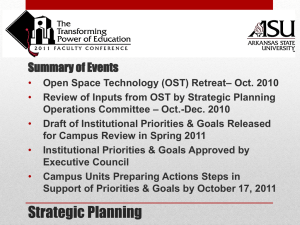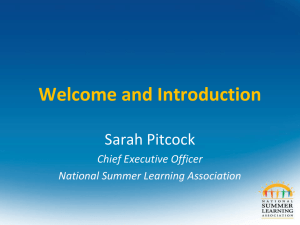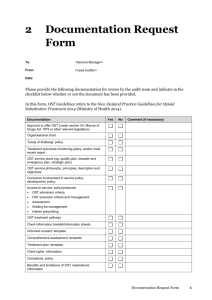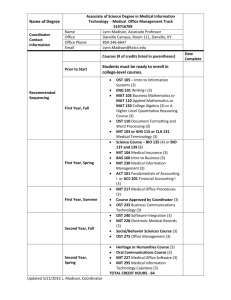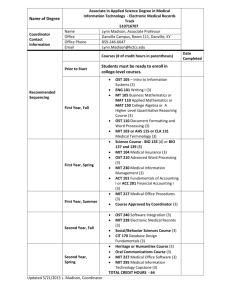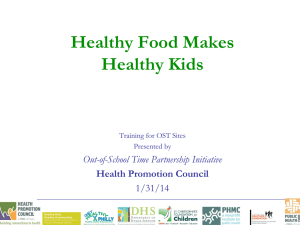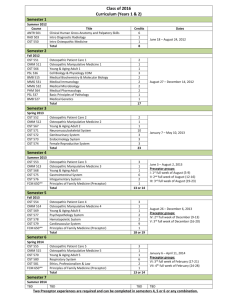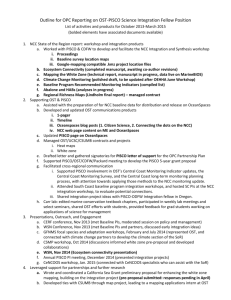WORKBOOK A: CREATING A COMMUNICATIONS PLAN
advertisement
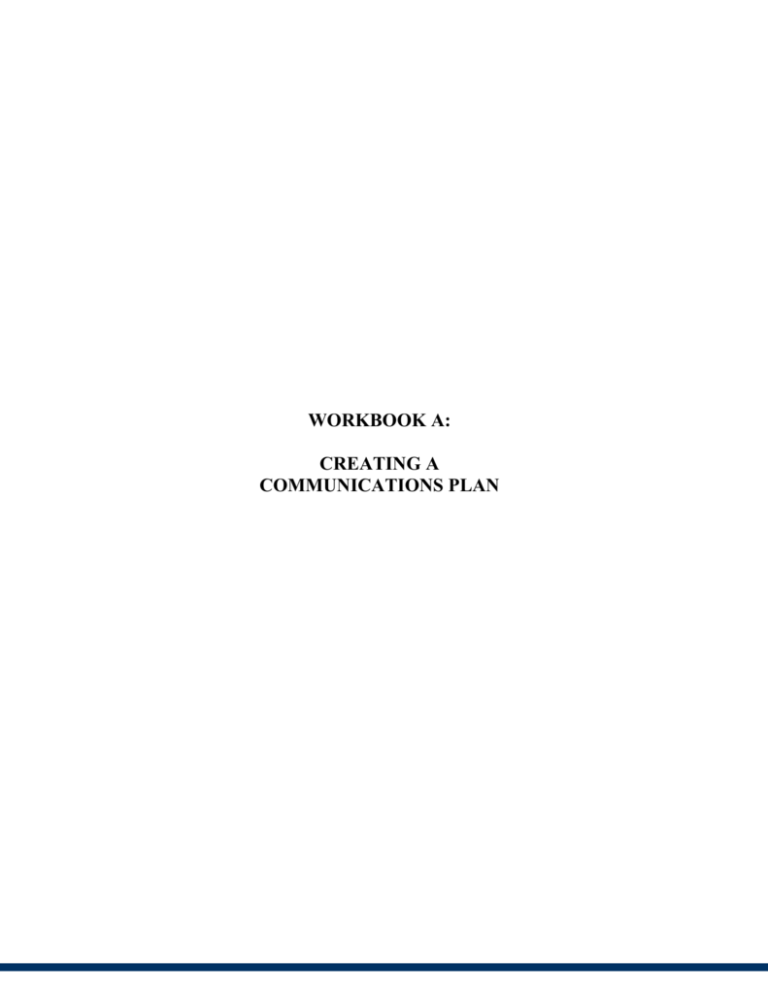
WORKBOOK A: CREATING A COMMUNICATIONS PLAN TABLE OF CONTENTS OVERVIEW OF COMMUNICATIONS PLANNING................................................. 3 Steps Involved in Creating a Communications Plan....................................................... 4 Deciding Whether or Not to Outsource Communications Planning ............................... 5 OUTSOURCING COMMUNICATIONS PLANNING................................................ 6 COMMUNICATIONS PLANNING USING INTERNAL RESOURCES:................. 7 1. Establishing the Goals for Your Communication Plan .............................................. 7 2. Defining Key Audiences ............................................................................................ 9 Who Do You Ultimately Want to Influence?.............................................................. 9 How Can You Reach Your Target Audiences?......................................................... 11 3. Identifying Key Messages........................................................................................ 12 4. Creating A Tactical Outreach Plan........................................................................... 14 Developing Your Media List..................................................................................... 14 Creating an Advisory Board ...................................................................................... 15 Media Training for Spokespeople ............................................................................. 16 Setting Up Editorial Board Meetings ........................................................................ 16 Hosting Community Forums ..................................................................................... 17 Arranging One-on-one Meetings with Key Influencers ............................................ 17 5. Developing Materials ............................................................................................... 19 Press Kits ................................................................................................................... 19 Press Releases............................................................................................................ 20 Op-ed Articles............................................................................................................ 21 Byline Articles........................................................................................................... 21 Letters to the Editor ................................................................................................... 21 Newsletters ................................................................................................................ 22 Public Service Announcements (PSAs) .................................................................... 22 B-Rolls (Background Videos) ................................................................................... 23 6. Specifying a Timeline .............................................................................................. 24 7. Post-study: Communicating Your Research Results .............................................. 26 Update Your Media Lists .......................................................................................... 26 Brief Your Advisory Board ....................................................................................... 26 Set Up an Editorial Board Meeting ........................................................................... 27 Host Community Forums .......................................................................................... 27 Arrange One-on-one Meetings with Key Influencers ............................................... 27 Update Your Press Kit............................................................................................... 28 Issue A Press Release ................................................................................................ 28 Host a Press Conference ............................................................................................ 28 Publish an Op-ed Article ........................................................................................... 29 Newsletters ................................................................................................................ 29 Reissue Your B-Roll.................................................................................................. 29 Timeline of Post-Market Study Outreach Efforts...................................................... 30 Workbook A -2- Creating a Communications Plan OVERVIEW OF COMMUNICATIONS PLANNING This workbook presents information about how to develop a communications plan for times when your OST Research Task Force needs to inform or educate key audiences or the general public about your work on OST programs. Why do you need a communications plan? A communication plan will help ensure the success of your community’s OST programming planning effort by engaging stakeholders in the process and shaping the way the effort is perceived by everyone invested in or affected by this issue. Your communication plan can help you raise public awareness of your community’s OST needs, challenges, and successes, and obtain needed funding and support. It can also help you to develop or enhance OST programming and increase enrollment. Most organizations that are conducting market research to guide their OST planning will have limited resources, both in terms of the amount of time and money they can spend on the process. Developing a strategic communications plan will help you make the most of your resources by establishing priorities and focusing on the most important tasks. Expect to learn a lot in developing your communication plan: you will clarify your objectives and zero in on your target audience. Furthermore, a solid communications plan will help ensure that everyone involved in your OST initiative is “on the same page” when they are communicating about the project with the rest of the world. There are two points at which effective communication is essential: At the beginning of the research process, when important stakeholders are identified and engaged with respect to OST programs. At the end of the research process, when the main tasks are reporting the market research findings and using the results to decide what kinds of OST programs will be created in your community. The steps involved in developing a communications plan are basically the same regardless of what stage of the research process you are in. In this workbook, we will focus on the first point, the beginning of the research process. At the conclusion of this workbook, we have included information about considerations for your communications plan at the end of your research process. Workbook A -3- Creating a Communications Plan Steps Involved in Creating a Communications Plan 1. Establishing the Goals for Your Communication Plan (What is your ultimate goal? How do your want your OST initiative to be perceived?) 2. Defining Key Audiences (Who do you ultimately want to influence, and how can you reach them?) 3. Identifying Key Messages (What messages are going to resonate most strongly with your key audiences?) 4. Creating a Tactical Outreach Plan (How are you going to get your messages to your audiences?) 5. Developing Materials (Descriptions of materials you may want to develop to convey your messages to your audiences.) 6. Specifying A Timeline (We present a recommended timeline to follow, coordinating your research and your communication plan.) 7. Post-study: Communicating Your Research Results (Considerations for communicating with your audience after your research has been completed.) Workbook A -4- Creating a Communications Plan Deciding Whether or Not to Outsource Communications Planning In determining whether or not to outsource all or part of your communications planning, it is important to consider your available resources. You may also decide to enlist the help of a consultant to help at the beginning or with certain aspects of marketing and communications. When to outsource communications planning: Consider hiring a marketing, advertising, or communications firm if: (1) you are concerned about presenting your ideas in the most positive light possible, or are uncertain about which means of communication will best serve your needs for your OST initiative; (2) if local media are unresponsive to your requests for coverage (e.g., won’t run public service announcements, refuse to send reporters, etc.); or (3) if key influencers in the market are opposed to OST programs for some reason and begin using local media (newspapers, radio, or television) to air their opposition. When to conduct communications planning using internal resources: Consider conducting your communications plan using internal resources if the members of your OST Research Task Force have sufficient knowledge, skills and understanding of marketing. In the next sections, we will present more detailed information regarding outsourcing your communications plan and conducting communications plans using internal resources. For communities conducting communications plans using internal resources, we will present information about each step in the process. Workbook A -5- Creating a Communications Plan OUTSOURCING COMMUNICATIONS PLANNING: A Guide to Hiring Vendors Who to hire: Marketing and communications agency Advertising agency Independent freelance consultant Public affairs organization What to look for: Has demonstrated skills and expertise in social marketing Experience working on community initiatives Experience working with diverse groups that include nonprofit and government organizations as well as businesses Where to find vendors: Talk to local nonprofit organizations and ask for a recommendation Local chamber of commerce or similar organizations Local industry organizations such as an advertising club or the Public Relations Society of America Speak with professors at a local college and ask for their recommendations What they will do: Discuss your objectives with you in detail Review market research information you have collected Create a communications plan designed to meet your objectives Produce necessary TV, radio, print, and/or web strategies What you will do: Provide vendor with a clear understanding of your objectives Provide vendor with market research data your organization has generated or obtained through other sources Be available for necessary public statements, interviews, debates What you should expect to pay: Fees vary widely depending on the scope of services and size of agency Expect to pay $1,500 to $10,000 for specific tasks, such as preparing press releases, developing a video, etc. Expect to pay $1,500 to $5,000 per month for a consultant who will work with you throughout the planning process and will create and execute a comprehensive communications plan for OST programs in your community Workbook A -6- Creating a Communications Plan COMMUNICATIONS PLANNING USING INTERNAL RESOURCES: 1. Establishing the Goals for Your Communication Plan The five steps involved in creating a communications plan are: (1) establishing goals; (2) defining key audiences; (3) identifying key messages; (4) creating a tactical outreach plan; and (5) specifying a timeline for moving forward. We will discuss each of these steps in turn. The first step to producing a successful communications plan is to establish a set of clear and measurable goals. These goals highlight the desired outcome of promoting the OST research initiative and are not the same as the defined expectations for the program itself. When you begin your OST research planning process, the objective of the communications plan is to engage important stakeholders’ participation in the design and execution of a market research study. As you complete the planning process, the objective of the communications plan shifts toward informing stakeholders of the results of the market research and setting the stage for broad community support for the OST programs you have come up with in response to the market research. Guidelines for creating the goals for your communications plan Your communications goals should be realistic and action-oriented. Goals should be specific and measurable. Keep to a minimal number of goals (e.g., one to three). You cannot achieve everything with one initiative. Know your audience (e.g., parents, stakeholders, media). Who will be receiving the messages you will be communicating? We will present more details about this step in the next section. For example, the goal for your initial communications plan could be, “Educate 90% of the stakeholders we’ve identified in our community about the OST planning process and OST programs we are considering.” Another goal might be to convert 70% of the stakeholders you have educated through various media into public advocates of the survey or whatever other market research process you engage in—or simply to “generate public support for the market research, ultimately leading to increased participation in the creation of OST programs.” Workbook A -7- Creating a Communications Plan POINTER When establishing your goals, be clear, direct, straightforward, and oriented toward solutions. Coming Up With Goals: A Checklist ; Solution-oriented goals (goals that can actually be achieved) are specific and focused rather than broad. ; Are your goals clear and pragmatic rather than vague and overwhelming? ; Can the goals be linked to indicators or measures so you know if you’ve succeeded? ; Remember that your communications plan resources include MONEY and TIME. Have you picked goals that can be met within your resource constraints? ; No communications plan changes everything. Have you chosen two or three goals that make the most sense given our mission? ; If your group spends more than an evening or two arguing about a goal, go back to your mission and choose an alternative. How long have you spent deciding on this goal? Source: Market Street Research, Inc., Trainer Information and Worksheets for School-Linked Services, Massachusetts Department of Education, Boston, Massachusetts, for training workshops held 1997 to 2001. Workbook A -8- Creating a Communications Plan 2. Defining Key Audiences Once the goals for your communications plan have been set, the strategies, the audience and the communications tactics will all be designed to help you meet these goals. If tactics are suggested that do not ultimately map back to your predefined goals, consider whether they will be worth the time and effort it will take to implement them. Who Do You Ultimately Want to Influence? Communications outreach is designed to deliver key messages to a targeted audience, ultimately resulting in greater education of the stakeholders about the program or issue. The targeted audience can be these stakeholders directly or anyone who can influence these stakeholders. What types of individuals should you involve to help you to reach your goals? Questions to Ask Yourself Who will ultimately benefit from the OST programs? Who will be responsible for implementing these programs? Who will be responsible for funding these programs? Cities, towns, counties, boroughs, and neighborhoods have different physical, demographic, and economic characteristics, as well as different forms of local government. Examples of individuals and groups that are often involved in OST planning, who benefit from OST programs, and who are responsible for implementing and funding these programs are included on the chart on the next page. POINTER Workbook A Be specific! After identifying the types of stakeholders you hope to reach, do some research or talk with people in your community to find out exactly who these people are. Aim to know them by name and think of them as individuals. For some types of stakeholders, it may be useful to know whether they have advisors or assistants, and who these individuals are. -9- Creating a Communications Plan Who are the stakeholders? Any group that is influential in the community in terms of OST should be considered stakeholders. Spend some time examining who the stakeholders and concerned constituencies are likely to be in your community—who needs to be involved in planning the market research? Who has resources that are critical? Are there strong ethnic or cultural communities? Examples of stakeholders include: Students, parents, and families Educators – principals, school superintendents, teachers, government organizations that support or are responsible for education, such as the state, county, or local Department of Education PTA or PTO organizations Government and political leaders, such as mayors, city or town councilors, or state or federal legislators Directors of community-based organization (CBOs), especially those that offer after-school and OST programs such as the YWCA, YMCA, Boys & Girls Clubs, 4-H, Future Farmers, Big Brothers/Big Sisters, Girl Scouts, Boy Scouts, or community centers Representatives from cultural and ethnic groups Leaders in business, especially businesses that support education initiatives and those who recognize the economic argument that OST programming is beneficial to employees, who are more likely to come to work if their children have safe options available when they are not in school Health care providers Prominent local funders, foundations, and philanthropists, as well as people who can mobilize local financial and other resources for OST programs Leaders in higher education, especially colleges and universities with an interest in supporting local communities Neighborhood leaders and grassroots organizers Representatives from faith-based organizations Representatives from social service agencies that serve children or are invested in child well-being Media representatives, including people from local newspapers, magazines, radio stations, television, cable, or internet media City agency representatives, such as officials from parks, libraries, or law enforcement officials Workbook A -10- Creating a Communications Plan How Can You Reach Your Target Audiences? Once you have defined your communications goals and the audiences you are trying to reach, the strategies you select will define how you are going to communicate to your audience. To create effective strategies, it is important to understand where and how your targeted audiences seek and receive information. For example, if you are having difficulty reaching the Mayor, does the Mayor have an assistant or issue researcher that is easier to contact? For reaching the community, some communities rely on regularly scheduled social and faith-based gatherings for word-of-mouth communication exchanges; these can be a good place to get your message across to parents, representatives from cultural and ethnic groups or faith-based organizations, or other stakeholders. Other stakeholders, such as recent immigrants, may be faced with language barriers and use cultural and/or community newspapers or bulletins as their preferred channels of communication. A comprehensive strategy featuring a diversity of audience-appropriate programs and resources will help you to achieve maximum outreach and efficient information sharing. Examples of this include but are not limited to the following: Leverage the media to provide editorial coverage of the issue and the ongoing programs Outreach to grassroots organizations and nonprofit groups with a vested interest in OST programs Use key influencers to help deliver the messages, through community forums, media opportunities and organized events Create direct mail pieces that can be distributed to your target audiences Leverage the internet for outreach to and education of your audiences Use local businesses that reach the community to help deliver messages Each strategy should map back to your goals and objectives, ultimately resulting in greater awareness, support and participation in the OST planning process and the marketing research study. POINTER Workbook A Be flexible. You will often need to adapt your campaign as you go forward to ensure success. Be persistent, but respectful. Reporters and editors receive huge piles of mail and e-mail. Be sure to send well-written executive summaries and fact sheets to make the request clear and concise. -11- Creating a Communications Plan 3. Identifying Key Messages What is a key message? Key messages are basically the messages you want your targeted audiences to see or hear. There are a lot of ways you can communicate about the same thing. For example, think about these two different ways you could communicate about a common topic, the weather. One person remarks, “At least it finally stopped raining.” Another says, “What a beautiful day; it’s wonderful to see the sun!” Both of these are equally true and appropriate ways to communicate about a day without rain, but they convey very different things about both the weather and the speaker. When you identify your key message, you are planning what you wish to communicate to your key audience about your OST initiative, your research process, your organization, and your mission. In developing the key messages for your communications plan, you need to know what issues are important to your key audiences. Think about your goals at this point in your research process: at this point, your primary goal is to increase stakeholder participation in designing and implementing a market research study. To do that, you need to figure out what issues will drive interest in the research. What will resonate with them? What will help you obtain their support? What is your “hook?” A good way to start is to identify likely strong supporters of OST programs and ask those people what they are most concerned about with respect to kids’ out-ofschool experiences. Questions to ask yourself after interviewing these individuals include: Which audience segment does the individual represent (e.g. parent, stakeholder)? What messages will ring true to which audience? Why are these issues important? What is the “call to action”? Why must the community support the effort? What are the benefits to being involved? Workbook A -12- Creating a Communications Plan Tips For Creating Successful Key Messages Have a limited number of messages you are trying to deliver. If you try to deliver more than three messages in your communications materials, they will lose focus, and ultimately your audience will walk away without hearing any of the messages. Each message should be concise – no more than 15-20 words. If you can’t fit your message on a bumper sticker, it is not yet focused enough. Make each message compelling; the greater the impact/import, the stronger the audience response will be. Each message should have a fundamental statement – the one thing you want your audience to know or understand about the OST Market Research Survey. The fundamental statement should be backed up by two to four key support points, including easily understood facts and figures. Finally, you can supplement these facts and figures with examples – such as an individual who has benefited from OST programs in the past. Examples of Possible Key Messages “The right OST programs can help students achieve significant academic progress.” More than XX percent of local students who participate in OST programs graduate from high school. Students who participate in OST programs have been shown to be more disciplined than students who are not involved in structured activities when not in school. “Students and parents will participate in OST programs if those programs fit their needs.” Research shows that the most important issue with OST programs is a concern for students’ safety. Students look for the social aspects of OST programs. If friends of a student are participating in OST programs, the student himself or herself is also more likely to want to participate. Workbook A -13- Creating a Communications Plan 4. Creating A Tactical Outreach Plan A good media relations program is critical to your communications plan due to the impact media can have in shaping the opinions of the individuals and organizations in your community. Think about the ways that media has impacted your community. If your community is like most, you have probably experienced local issues that have generated a lot of press, whether positive or negative, and that press has in turn generated a lot of positive or negative word of mouth. When people read a positive story about the OST initiative or see an editorial in support of the research you are conducting, they are more likely to have a favorable opinion of your initiative. In creating your tactical outreach plan, you are strategizing to get the most attention—and the most positive attention—for your initiative, and in so doing generate the most support for your effort. There are a wide variety of tactics that can be used to disseminate your OST message, which we will discuss on the following pages. In this section, we will discuss strategies relating to specific actions you can take: (1) developing your media list; (2) creating an advisory board; (3) media training for spokespeople; (4) setting up editorial board meetings; (5) hosting community forums; and (6) arranging one-on-one meetings with key influencers. In the next section, we will describe a variety of materials that you can develop as part of your tactical outreach plan. Developing Your Media List Before you can reach out to the media, you need to know which outlets (e.g. community newspapers, talk radio, etc.) and specific contacts (e.g., education reporters, editors, news directors, etc.) to reach out to. To do so, it is also important to learn the primary news sources your audiences rely on for facts and information. Types of Media Daily and community newspapers Local TV and cable stations – both news and public service programs Local radio and public service programs Internet media – community sites, news sites and blogs Newsletters that target your audiences Workbook A Contacts to Reach Out to At the larger outlets, consider reaching out to education reporters and reporters who cover your community At the smaller outlets, such as community newspapers, reach out to the editor If you are hosting an event, make sure the local TV assignment editors are aware of it If you are looking for a feature story in the news, consider pitching the producer or the news planning editor At the radio stations, target both the news director and the public service director (often, these are the same people) For newsletters, target the editor For internet media, reach out to the writer -14- Creating a Communications Plan POINTER Take some time to research the types of reporters and outlets you are looking to reach. Know who you want to reach and the format in which they prefer to receive information. Do they prefer information mailed to them or sent via e-mail? Most reporters get significant amounts of mail and e-mail. By targeting the appropriate reporters, you will have a better chance at success. Creating an Advisory Board Creating an advisory board for your OST initiative can be very beneficial. It adds instant credibility to your outreach efforts when you show a list of people who are supporting the initiative. These individuals can be used as spokespeople for the media and at community forums. Also, each of these individuals has a constituency of people whom they influence. In creating the advisory board: Know what specific value each individual brings to the board Choose well-respected people within the community Choose people who represent each of your target audiences Establish measurable goals for each member Choose people who are vested in the issue and have deep knowledge of OST programs Choose business leaders who have demonstrated interest in educational initiatives Choose individuals who have a sphere of influence that can help engage stakeholders, such as principals, ministers, directors of OST programs Utilizing an advisory board Hold an initial meeting with the advisory board to brief them on the plans for a market research survey Once your advisory board has been briefed, ask them to distribute materials regarding the market research survey to their organizations Ask your advisory board members to sign prewritten op-ed pieces and submit them to the local newspaper Ask your advisory board to host community forums to educate the public about the OST market research survey Also consider including members of your advisory board in editorial board meetings and press briefings. Workbook A -15- Creating a Communications Plan Media Training for Spokespeople If your spokespeople have not been media-trained, consider engaging a professional media trainer to work with them prior to beginning the campaign. A media trainer can help your spokespeople in presentation skills, delivering the key messages in a targeted and concise manner, responding to challenging questions and situations and working with reporters to ensure the messages are delivered. Setting Up Editorial Board Meetings The editorial board at a major newspaper is very influential: it determines what issues will be focused on and what the paper’s stand on these issues will be. Given the great impact that the newspaper’s position on an issue will have on public perception, an editorial board meeting can significantly assist your OST initiative. A briefing with the editorial board does not guarantee they will write about the issue, however. More importantly, there is no guarantee they will support the issue. You will therefore need to plan carefully and strategize for an editorial board meeting. For the best chance of success with an editorial board meeting: Understand the political bent of the editorial board prior to meeting with them. This will become clear after reading a number of their opinions. Know how they have sided on similar issues in the past. Bring two to three people at most to an editorial board meeting. Make sure these people are well-versed in both sides of the issue and can clearly articulate the key messages and answer questions. An editorial board meeting is a perfect time to involve an influential member from your advisory board. Provide the editorial board with materials that demonstrate the case in support of OST programs and the research being conducted. POINTER Setting up an editorial board meeting may take some time. Editorial boards do not necessarily meet on a regular basis and they may be focused on a number of other issues. Do not try to meet with an editorial board during a political campaign season. They tend to be extremely busy as candidates vie for local endorsements. Pay attention to pressing community issues. Make sure the OST research story is not in competition with other major news or education stories. Workbook A -16- Creating a Communications Plan Hosting Community Forums Similar to a town meeting, a community forum enables OST initiative leaders to have interactive discussions with a target audience. Community forums can be held in advance of the market research survey in order to build support for the initiative while educating and engaging the stakeholders. You may wish to host a series of community forums, each one targeted to a different audience. For example, you could make arrangements to host a series of community forum at a local recreation center or school auditorium; you might invite parents of elementary school students to attend one night, students the next, and educators the next. By keeping the audiences targeted, you will garner a deeper knowledge of the issues that affect each audience. POINTER Hold the community forum in a public space that is easily accessible to the audience. Invite individuals to the community forum through announcements in the local media, letters of invitation, and email invitations. In hosting a community forum, make sure that the people you select to speak to the audience are well-versed in the issue and articulate. A good format for such a forum is a presentation followed by a Q&A (question and answer session). Keep the presentation short, concise and on-message. You want to keep the audience engaged and alert to participate in the Q&A that will follow. Arranging One-on-one Meetings with Key Influencers Before you engage in a public discussion of OST programs and the market research survey, it will be critical to garner the support of key influencers in the community, including politicians, educators and ministers. The first step in garnering this support is to arrange one-on-one meetings (also called “road shows”) with people whose support will be important for engaging stakeholders. These people could include: City councilors or town managers Mayor or Chair of the Board of Selectmen Superintendent of Schools Local Ministers Heads of neighborhood organizations Head of the local PTO/PTA Head of local ethnic organizations Make sure to meet with anyone who is involved in OST programs or education initiatives. These are people who could be called by the media for their reaction, and it’s important that they are briefed before they receive such phone calls. Workbook A -17- Creating a Communications Plan Some Common Communications Challenges: Strategies to Use Consider adjusting your message The Media Isn’t Interested The media is often being pitched on thousands of issues a week. The challenge is to make your message and issue stand out among all others. Use real-life, local examples that have had an impact on the local community Try a different reporter (or media source) Use photos, pictures, graphics, clear and interesting summary charts Offer credible experts on educational topics Ask local businesses with a community focus on education initiatives to sponsor your campaign We Have No Budget to Create Materials While PSAs and placards can certainly help in creating awareness of the program, there are alternative ways to get the materials you need to ensure the success of the program. People Aren’t Paying Attention to the Materials and Messages Many of the individuals you are targeting are very busy. Some are managing large amounts of business; others are single parents who work long hours to make ends meet. Rather than expecting individuals to pay attention, try delivering messages in the places people will be during their everyday lives. Workbook A -18- Approach local TV and cable stations and ask them to produce PSAs for you Approach local radio stations and ask for the same thing Approach a local printer and ask if they might be willing to donate printing for the campaign Commuter stations Bus placards Utility bills (gas, electric, telephone, water, etc.) Information at Parent/Teacher nights Cable access programs Municipal or school websites Church bulletins Nonprofit newsletters Local places where people post and read notices, such as laundromats, coffee shops, etc. Creating a Communications Plan 5. Developing Materials In this section, we will provide brief descriptions of a variety of materials that you may want to develop as part of your tactical outreach plan. Some of these materials, such as a press kit, are necessary for you to have a solid communications plan. Many of these materials can be produced affordably and easily using internal resources. For example, someone in your OST Research Task Force with good writing skills can write a press release, op-ed article, or letter to the editor. Other materials (such as background videos) may be more expensive or challenging to produce using internal resources and may not be necessary, depending on your community’s particular communications plan. You do not need to develop each of these materials to have a good media relations program. Use the goals you identified at the beginning of your communications planning to help you determine which materials will do the best job at meeting those goals while making the most of your resources. Press Kits A press kit is the foundation of a media relations program. It consists of all the information about your issue, usually placed in a folder branded with the name of your campaign. The press kit should be organized in a manner that is easy for the news media to use. Samples of a fact sheet and a press advisory that were created for a fictitious community are included on the CD of prototype materials included with this guide.. Items that are typically included in a press kit Overview of the OST issue and initiative Key facts about OST programs Biographies of the spokespeople List of individuals on your advisory board A couple of stories on current trends and issues Pictures of current OST programs POINTER Workbook A In addition to hard copies of the materials, a website should be created for the OST initiative. Electronic press kits developed on your organization’s website extend and integrate the campaign’s internal and external components. The e-kit can contain all the same elements as the hard copy format with direct access links to provide real time response to media and public inquiries. -19- Creating a Communications Plan Press Releases Press releases can be issued on a variety of news announcements or trend stories. A press release should tell the story or news you are trying to deliver. A sample press release is included on the CD of prototype materials included with this guide. Elements of a good press release include: Newsworthy information. Clear dissemination of information and an understanding of why this information is important. One or two paragraphs at the beginning about the survey followed with an identification of those who are spearheading the initiative. The first two sentences of your release are the most important. Make sure they are strong and clear. Keep to the facts. Provide contact information for the organization, including name, phone, email, fax and website address Two types of press releases Announcement Release: Announcement releases are often issued on topics such as new initiatives, the firm hired to conduct the research, etc. Issue your announcement press release about the OST market research survey before it begins. It should talk about why the survey is being conducted, the issues that deemed it necessary, the qualifications of the group who is conducting the survey, and the expected timeline for results. The press release should also include a quote from a high-ranking individual within the organization driving the initiative. Trends Release: This release should be about trends in OST programs and why it is critical to create OST programs that have high levels of participation. A trend release doesn’t revolve around a specific announcement. Rather, it is timeless—or at least has a long shelf-life. These releases should provide enough facts and figures about OST programs to spark interest on the part of the reporter. Workbook A -20- Creating a Communications Plan Op-ed Articles Op-ed articles run in the newspapers, opposite the editorial page. Op-ed articles provide individuals with an opportunity to comment on issues that affect the community. They are also a unique forum for sharing, emphasizing, and reiterating the established key messages from your OST initiative in a clear and concise manner. Newspapers receive a significant number of op-ed articles, so there are a few things you can do to increase your chances of placing yours: Talk to the editor in advance and determine if they are interested in the topic you are addressing. Have the op-ed article signed by a prominent person in the community. Understand the guidelines for an op-ed. Many newspapers have preset limits on words. If you go over, the op-ed is likely to be tossed or cut. Tie your issue to a current event or news story. For example, an op-ed on OST programs is much more likely to be picked up during the first week of school. A sample Op-Ed piece is included on the CD of prototype materials included with this guide. Byline Articles A byline article is similar to an op-ed in that it is signed by a prominent person who has credibility in their field. Not necessarily an opinion piece, it can offer the facts and figures about OST programs. Many trade journals and community newspapers will run bylined articles. They often book up in advance, however. Call the editor of the publication and find out if they accept bylined articles and if so, what the guidelines are. Many of them will tell you to submit an abstract of the article in advance and if approved, they will then ask you to submit the entire article. Once published, reprints of the article can then be distributed in your press kit and in packets of information offered at community group meetings. They can also be placed on your website. Letters to the Editor Most newspapers run daily letters to the editor, allowing individuals the opportunity to comment on recent news stories or local initiatives. Newspapers publish as many of these letters as possible. To increase your chances of having letters published: Keep it short and concise. Focus on a single point. Make it timely and relevant. Know the guidelines for letters to the editor before you submit your letter. Workbook A -21- Creating a Communications Plan Newsletters Creating a newsletter that can be distributed to the target audiences is one way to communicate with your audience on a regular basis. Either by email or postal mail, a newsletter is delivered directly to your target audience, without the filters put on a story by a third party. Newsletters can also be sent to nonprofit organizations or business associations that have an interest in OST programs. Possibilities for newsletter content A letter from the individual or group spearheading the initiative The timeline for the survey results Recent press clips Profiles of advisory board members Key dates and profiles of individuals currently participating in OST programs Public Service Announcements (PSAs) A public service announcement is free airtime that radio and television stations give to nonprofit organizations. This airtime is based upon openings in the TV and radio advertising schedules, and usually is not during primetime for viewers. PSAs vary in length – they are typically 20, 30 or 60 seconds long. For radio, PSAs can be either live copy that is read by the DJ or pre-recorded spots, if you have the budget to produce them. For television, PSAs should be pre-recorded in the format used by the television station. Despite the limitations of minimal prime time airtime, PSAs are still an effective tool to impart key message points and extend the reach of message. Samples PSAs are included on the CD of prototype materials included with this guide. POINTER Workbook A For placement, contact the public service director at the station. They can tell you what the requirements are for the station and how far in advance PSAs should arrive at the station. If your PSA is irrelevant after a certain date, be sure to clearly mark that date on the packaging. -22- Creating a Communications Plan B-Rolls (Background Videos) B-rolls, or background videos, may help in getting your news on television. Many TV stations are limited in their ability to send camera crews to all the stories they would like to cover. If you can provide B-roll of current OST programs along with your news release, however, it may help to generate coverage. Things to keep in mind when shooting B-roll: It must be broadcast quality. That is typically digital or beta footage – not a VHS tape. Know ahead of time what format your station would like to receive it in. It should show the human interest side of OST programs, including students currently involved in the programs. Audio is not necessary. Send along an accompanying background sheet with critical facts and points of interest. Workbook A -23- Creating a Communications Plan 6. Specifying a Timeline Below, the timeline we recommend for implementing steps in your communications plan in conjunction with your OST market research timeline: Twelve Weeks prior to beginning Market Research Study ; Begin research to determine the situation analysis, including current status of OST programs, who supports these programs, why programs are not supported, which neighborhoods and ethnic groups participate in the programs ; Define the community you are trying to reach ; Understand why key stakeholders need to be involved Ten weeks prior to the Study ; Define the goals and objectives of the communications program ; Define the key audiences of the program ; Detail the strategies you plan to use Eight Weeks prior to the Survey ; Develop the key messages ; Begin development of press kit materials ; Begin outreach to advisory board members Six weeks prior to the Survey ; Begin development of media lists ; Begin development of press kit materials Four weeks prior to the Survey ; Shoot B-roll for distribution to television stations ; Media-train your spokespeople ; Schedule editorial board meetings ; Begin one-on-one meetings (“road shows”) with key influencers Two weeks prior to the Survey ; Create press release announcing the program ; Draft and distribute PSAs ; Begin hosting community forums Workbook A -24- Creating a Communications Plan As the Survey begins ; Draft and pitch trend story to the media ; Place op-ed article and bylined article ; Place letters to the editor ; Distribute newsletter to your target audience Workbook A -25- Creating a Communications Plan 7. Post-study: Communicating Your Research Results When you have completed your market research, it is critical that you use the research results to continue to engage your key stakeholders. The elements of a tactical outreach plan for communicating market research results are similar in many respects to those we have just discussed in this workbook. In this section, we provide information about how to tailor your communications plan for this stage in your OST market research process. Update Your Media Lists Most of the media contacts you developed during the initial planning will still be relevant when communicating the results of your OST program market research. Use this time to update your lists, adding any additional reporters with whom you built relationships during Phase I. POINTER Be sure to add assignment editors at the local TV stations to your media list. You may want to hold a press conference to deliver the results of your OST market research, and they would be the contact for that type of event. Brief Your Advisory Board Your advisory board is a critical ally as you begin to unveil the results of the survey. These individuals can be used as spokespeople for the media and at community forums as well as to their own constituency. They must be briefed on the results of the survey as soon as possible. They will be on the frontline of the presentation and it is critical they have a clear understanding of the results and the key messages that are being delivered. Once your advisory board has been briefed, ask them to distribute materials regarding the market research survey to their organizations. They may also be asked to sign op-ed pieces, and participate in community forums and press briefings. Workbook A -26- Creating a Communications Plan Set Up an Editorial Board Meeting When you initially meet with the editorial board, ask them if you can come back and meet with them prior to releasing the results of the survey. If so, schedule this meeting in time to brief them on the results and garner editorial opinions on the day the results are released. If you cannot schedule a second meeting, make sure to send them a copy of the results in advance, under embargo, to ensure they are well-briefed prior to the announcement of the results. Host Community Forums Community forums will once again be very important, giving you the opportunity to present the information directly to the target audience and hear their immediate response. Prepare in advance so you understand what issues may be of concern to the individual audiences you are meeting with. Spokespeople should be briefed on potential issues and prepared to offer solutions in advance. As with your initial community forums, a good format would be a short presentation on the results followed by a Q&A. Arrange One-on-one Meetings with Key Influencers Before you engage in a public discussion of the survey results, it will once again be critical to pre-brief key influencers in the community, including politicians, educators and religious leaders. The first step in garnering this support is to arrange one-on-one meetings with a handful of individuals whose support can be helpful in influencing the stakeholders. These people could include: City councilors or town managers Mayor or Chair of the Board of Selectmen Superintendent of Schools Local Ministers Heads of neighborhood organizations Head of the local PTO/PTA Head of local ethnic organizations POINTER Workbook A Make sure to meet with anyone who is involved in OST programs or education initiatives. These are individuals who could be called by the media for reaction to the survey results. It will be important that they are briefed before they receive such phone calls. -27- Creating a Communications Plan Update Your Press Kit The foundation of your press kit remains the same. Continue to include information about the issue, key facts about OST programs, bios of spokespeople, a list of advisory board members, and pictures on current OST programs. You should now include a full copy of the survey, including information on the process that was undertaken. A press release should be drafted highlighting the results and recommendations. POINTER Add the new information to your organization’s website, where it can be easily accessed by the media. Issue A Press Release You will need to issue a press release highlighting the results of the survey. The press release should lead with the most significant findings and recommendations. In the body of the release, include a recap of the findings and recommendations, as well as next steps. Consider including a quote from the lead researcher on the project as well as the individual leading the initiative. POINTER When issuing the press release, include a fact sheet that highlights the results of the study. Host a Press Conference You may want to consider hosting a press conference to release the results. At the conference, it will be important to have not only representatives from your organization and the research firm, but also key community influencers who are supporting the initiative. POINTER Stage the press conference on a day and time that would be most conducive to coverage (in the morning around 10 a.m.). You may also want to hold it at a local OST site with kids, parents, and other stakeholders in attendance. Another possibility is to recruit articulate children and parents to serve as spokespeople at the press conference or at other public events. A media advisory would be drafted and sent out to the media the day prior to the press conference. At the conference, a few slides can be shown highlighting the results. The media should also be provided with a complete set of the findings and recommendations. Workbook A -28- Creating a Communications Plan Publish an Op-ed Article Talk to the op-editor prior to releasing the survey results. Let them know when the results would be issued and determine if there is a possibility of getting an op-ed placed on that day. The op-ed should highlight the survey results and recommendations based on the research. The op-ed should be signed by a prominent person in the community and should stick within the published guidelines. If you cannot get an op-ed, consider writing another letter to the editor that highlights the results of the study. Newsletters Release another issue of the newsletter the week the survey results are announced. This will enable you to deliver the results directly to the target audience. The newsletter could contain content such as: A letter from the head of the organization recapping the reasons the survey was conducted and what the results mean Highlights of the results and recommendations Details of the next steps for the initiative Recent press comments Reissue Your B-Roll Your background video can be reissued to the TV stations in conjunction with the announcement release. POINTER Workbook A Include some updated graphics that demonstrate the results of the survey and recommendations. This could accompany the press release when it is sent to the news planning editors or be distributed at a press conference announcing the results. -29- Creating a Communications Plan Timeline of Post-Market Study Outreach Efforts As the study is being conducted: ; Update media lists Once the results have been finalized ; Draft press release ; Advisory board briefings ; Update B-roll ; Editorial board meetings ; Update press kit Day of survey release ; Press conference ; Placement of Op-Ed ; Placement of letter to the editor The week results are released ; Community forum ; Road shows ; Newsletter Workbook A -30- Creating a Communications Plan

